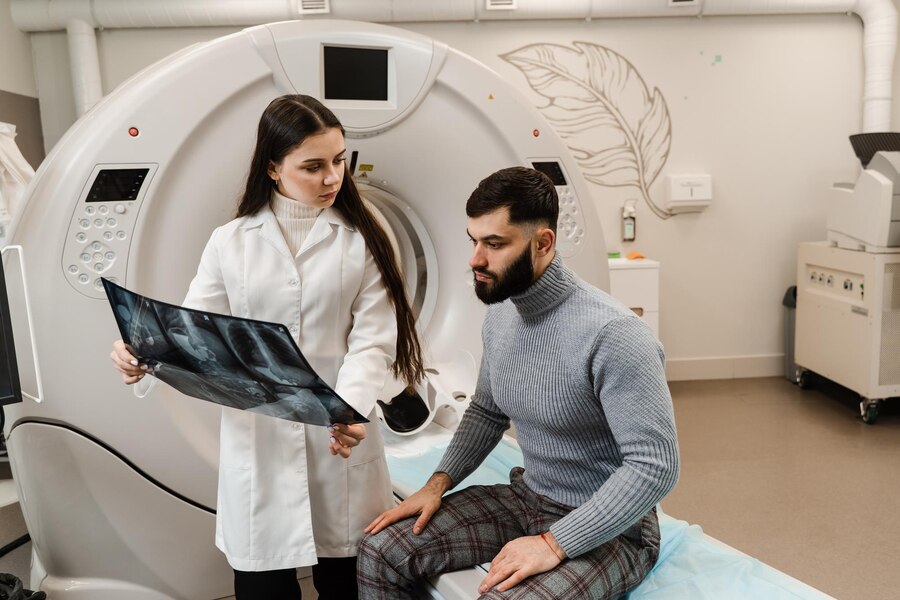Diagnostic radiology encompasses a broad spectrum of medical imaging techniques that use various forms of radiant energy to create images of the internal structures of the body. These images provide valuable information to healthcare providers for diagnosing diseases, planning treatment, and monitoring treatment progress.
Types of Diagnostic Imaging Techniques
-
X-ray:
- One of the oldest and most widely used imaging techniques, X-rays use electromagnetic radiation to produce images of bones, teeth, and other internal structures.
- X-rays are commonly used to diagnose fractures, pneumonia, and other conditions.
-
Computed Tomography (CT) Scan:
- CT scans use X-rays and computer processing to create detailed, cross-sectional images of the body.
- CT scans provide more detailed information than traditional X-rays and are used to diagnose a wide range of conditions, including cancer, heart disease, and stroke.
-
Magnetic Resonance Imaging (MRI):
- MRI uses a powerful magnetic field and radio waves to create detailed images of organs and tissues.
- MRI is particularly useful for imaging soft tissues such as the brain, spinal cord, muscles, and ligaments.
-
Ultrasound:
- Ultrasound uses high-frequency sound waves to create images of internal organs and structures.
- Ultrasound is commonly used for prenatal imaging, diagnosing heart conditions, and examining organs such as the liver, kidneys, and gallbladder.
-
Nuclear Medicine Imaging:
- Nuclear medicine imaging techniques, such as positron emission tomography (PET) scans, use radioactive tracers to create images of organs and tissues.
- These scans can help to detect cancer, assess heart function, and evaluate the spread of disease.
-
Fluoroscopy:
- Fluoroscopy uses continuous X-rays to create real-time images of the body, allowing doctors to visualize the movement of organs and guide medical procedures such as angiograms and catheterizations.
The Role of Diagnostic Radiology in Healthcare
-
Disease Diagnosis:
- Diagnostic imaging plays a crucial role in the diagnosis of a wide range of medical conditions, including cancer, heart disease, stroke, fractures, and neurological disorders.
-
Treatment Planning:
- Imaging studies help healthcare providers to plan and guide treatment procedures, such as surgeries, biopsies, and radiation therapy.
-
Monitoring Disease Progression:
- Diagnostic imaging can be used to monitor the progression of diseases, assess the effectiveness of treatment, and detect any recurrence.
-
Early Disease Detection:
- Regular screening tests, such as mammograms and colonoscopies, can help to detect diseases such as cancer at an early stage, when treatment is often more effective.
-
Guiding Medical Procedures:
- Imaging techniques such as fluoroscopy are used to guide minimally invasive procedures, such as angioplasties and stent placements.
The Importance of Skilled Radiologists
-
Image Interpretation:
- Radiologists are highly trained physicians who specialize in interpreting medical images.
- They possess the expertise to accurately analyze images and provide crucial information to other healthcare providers for diagnosis and treatment planning.
-
Patient Care:
- Radiologists play a vital role in patient care by providing accurate and timely diagnosis, which can significantly impact treatment outcomes.
-
Technological Advancements:
- Radiologists are constantly adapting to advancements in imaging technology, ensuring that patients have access to the latest and most effective diagnostic tools.
FAQs About Diagnostic Radiology Services
1. What are the risks associated with diagnostic imaging procedures?
- Most diagnostic imaging procedures involve minimal risk. However, some procedures, such as CT scans, involve exposure to radiation. Your doctor will carefully weigh the benefits and risks of each procedure before recommending it.
2. How can I prepare for a diagnostic imaging procedure?
- Preparation varies depending on the specific procedure. You may be asked to fast or avoid certain medications before the exam. Your healthcare provider will provide you with specific instructions.
3. What happens after a diagnostic imaging procedure?
- The radiologist will interpret the images and provide a report to your referring physician. Your physician will then discuss the results with you and explain any necessary next steps.
Conclusion
Diagnostic radiology plays an indispensable role in modern healthcare, providing valuable insights into the human body and enabling accurate diagnosis and effective treatment of a wide range of medical conditions.
By utilizing advanced imaging technologies and the expertise of skilled radiologists, healthcare providers can provide the best possible care for their patients.
Reach out to our Texas Specialty Clinic for Radiology Diagnostic services (469) 496-2456 or visit us https://texasspecialtyclinic.com/

